Chinese Room Argument: Understanding and Consciousness in AI
VerifiedAdded on 2023/01/13
|10
|3362
|42
AI Summary
This essay delves into the Chinese Room Argument, which questions the ability of computers to understand and possess consciousness. It explores the debate surrounding artificial intelligence and its implications for understanding and intentionality.
Contribute Materials
Your contribution can guide someone’s learning journey. Share your
documents today.

Essay
1
1
Secure Best Marks with AI Grader
Need help grading? Try our AI Grader for instant feedback on your assignments.
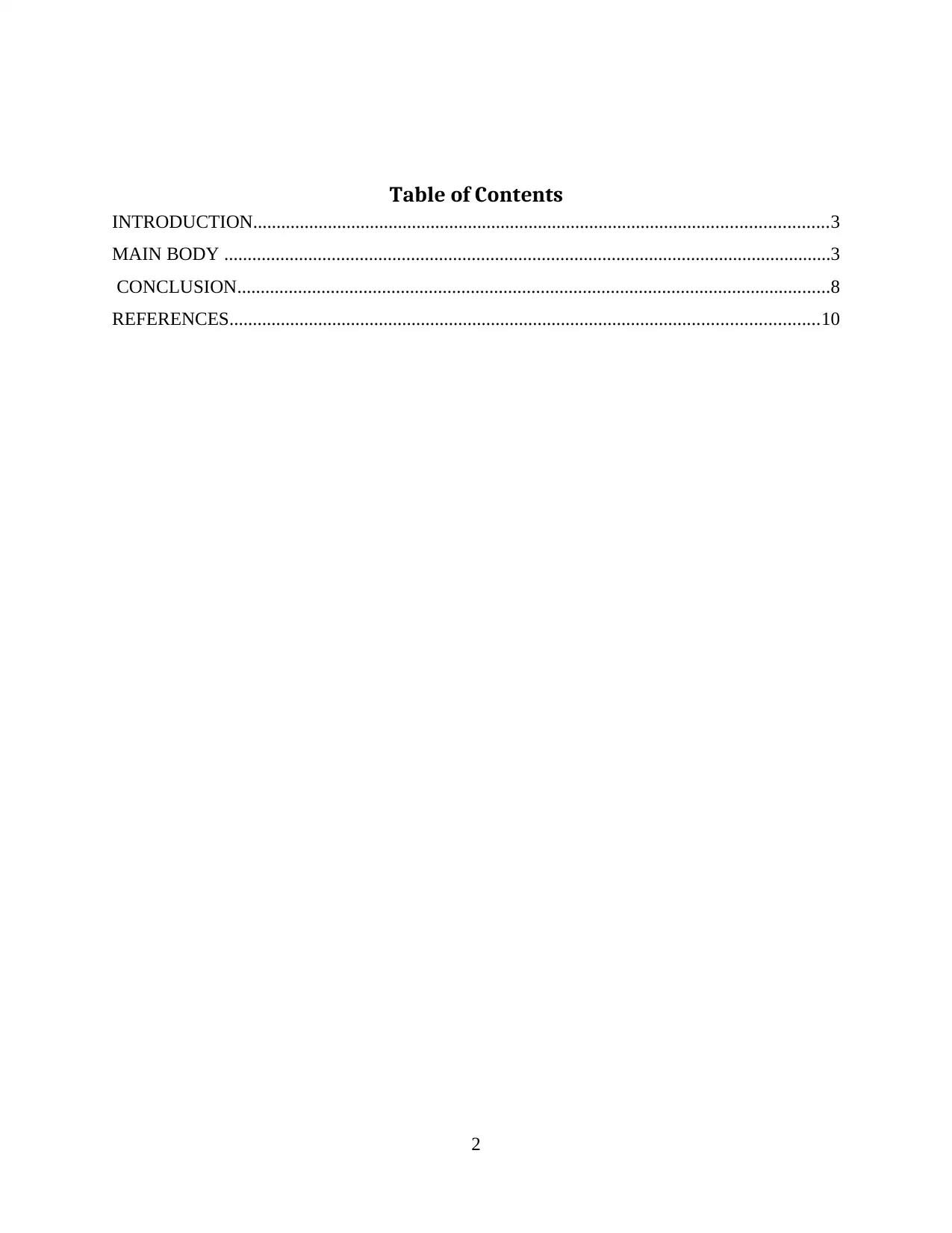
Table of Contents
INTRODUCTION...........................................................................................................................3
MAIN BODY ..................................................................................................................................3
CONCLUSION...............................................................................................................................8
REFERENCES..............................................................................................................................10
2
INTRODUCTION...........................................................................................................................3
MAIN BODY ..................................................................................................................................3
CONCLUSION...............................................................................................................................8
REFERENCES..............................................................................................................................10
2
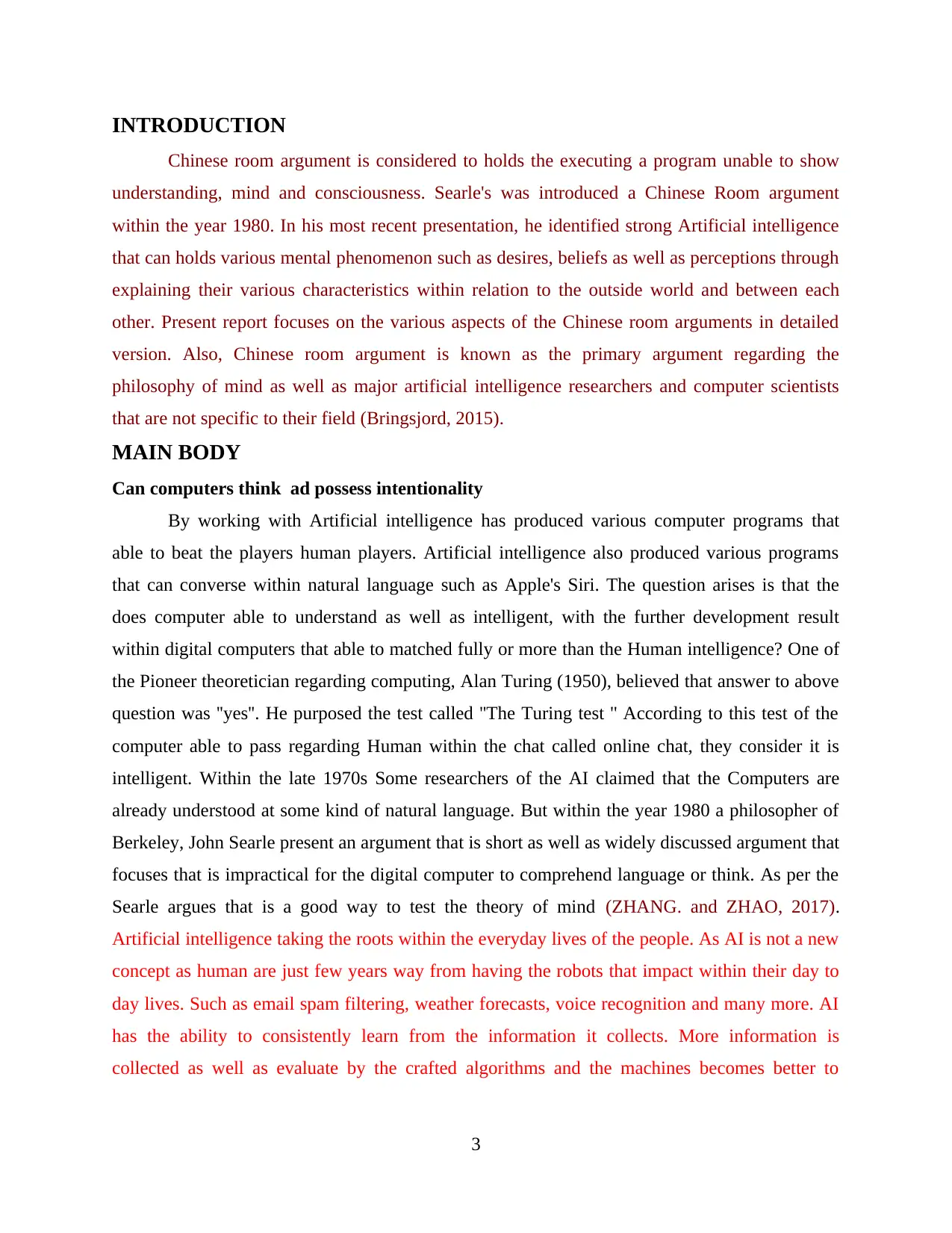
INTRODUCTION
Chinese room argument is considered to holds the executing a program unable to show
understanding, mind and consciousness. Searle's was introduced a Chinese Room argument
within the year 1980. In his most recent presentation, he identified strong Artificial intelligence
that can holds various mental phenomenon such as desires, beliefs as well as perceptions through
explaining their various characteristics within relation to the outside world and between each
other. Present report focuses on the various aspects of the Chinese room arguments in detailed
version. Also, Chinese room argument is known as the primary argument regarding the
philosophy of mind as well as major artificial intelligence researchers and computer scientists
that are not specific to their field (Bringsjord, 2015).
MAIN BODY
Can computers think ad possess intentionality
By working with Artificial intelligence has produced various computer programs that
able to beat the players human players. Artificial intelligence also produced various programs
that can converse within natural language such as Apple's Siri. The question arises is that the
does computer able to understand as well as intelligent, with the further development result
within digital computers that able to matched fully or more than the Human intelligence? One of
the Pioneer theoretician regarding computing, Alan Turing (1950), believed that answer to above
question was ''yes''. He purposed the test called ''The Turing test '' According to this test of the
computer able to pass regarding Human within the chat called online chat, they consider it is
intelligent. Within the late 1970s Some researchers of the AI claimed that the Computers are
already understood at some kind of natural language. But within the year 1980 a philosopher of
Berkeley, John Searle present an argument that is short as well as widely discussed argument that
focuses that is impractical for the digital computer to comprehend language or think. As per the
Searle argues that is a good way to test the theory of mind (ZHANG. and ZHAO, 2017).
Artificial intelligence taking the roots within the everyday lives of the people. As AI is not a new
concept as human are just few years way from having the robots that impact within their day to
day lives. Such as email spam filtering, weather forecasts, voice recognition and many more. AI
has the ability to consistently learn from the information it collects. More information is
collected as well as evaluate by the crafted algorithms and the machines becomes better to
3
Chinese room argument is considered to holds the executing a program unable to show
understanding, mind and consciousness. Searle's was introduced a Chinese Room argument
within the year 1980. In his most recent presentation, he identified strong Artificial intelligence
that can holds various mental phenomenon such as desires, beliefs as well as perceptions through
explaining their various characteristics within relation to the outside world and between each
other. Present report focuses on the various aspects of the Chinese room arguments in detailed
version. Also, Chinese room argument is known as the primary argument regarding the
philosophy of mind as well as major artificial intelligence researchers and computer scientists
that are not specific to their field (Bringsjord, 2015).
MAIN BODY
Can computers think ad possess intentionality
By working with Artificial intelligence has produced various computer programs that
able to beat the players human players. Artificial intelligence also produced various programs
that can converse within natural language such as Apple's Siri. The question arises is that the
does computer able to understand as well as intelligent, with the further development result
within digital computers that able to matched fully or more than the Human intelligence? One of
the Pioneer theoretician regarding computing, Alan Turing (1950), believed that answer to above
question was ''yes''. He purposed the test called ''The Turing test '' According to this test of the
computer able to pass regarding Human within the chat called online chat, they consider it is
intelligent. Within the late 1970s Some researchers of the AI claimed that the Computers are
already understood at some kind of natural language. But within the year 1980 a philosopher of
Berkeley, John Searle present an argument that is short as well as widely discussed argument that
focuses that is impractical for the digital computer to comprehend language or think. As per the
Searle argues that is a good way to test the theory of mind (ZHANG. and ZHAO, 2017).
Artificial intelligence taking the roots within the everyday lives of the people. As AI is not a new
concept as human are just few years way from having the robots that impact within their day to
day lives. Such as email spam filtering, weather forecasts, voice recognition and many more. AI
has the ability to consistently learn from the information it collects. More information is
collected as well as evaluate by the crafted algorithms and the machines becomes better to
3
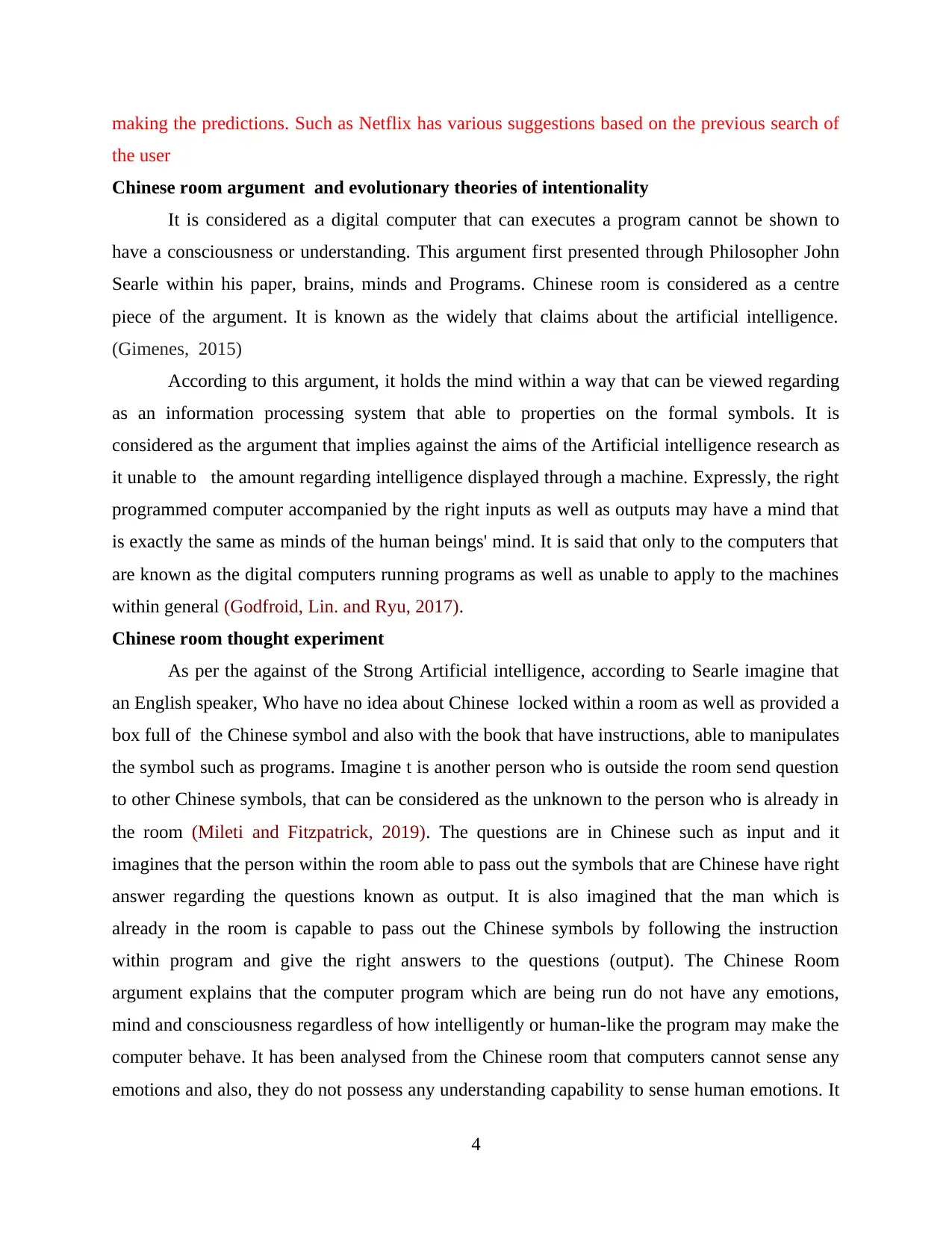
making the predictions. Such as Netflix has various suggestions based on the previous search of
the user
Chinese room argument and evolutionary theories of intentionality
It is considered as a digital computer that can executes a program cannot be shown to
have a consciousness or understanding. This argument first presented through Philosopher John
Searle within his paper, brains, minds and Programs. Chinese room is considered as a centre
piece of the argument. It is known as the widely that claims about the artificial intelligence.
(Gimenes, 2015)
According to this argument, it holds the mind within a way that can be viewed regarding
as an information processing system that able to properties on the formal symbols. It is
considered as the argument that implies against the aims of the Artificial intelligence research as
it unable to the amount regarding intelligence displayed through a machine. Expressly, the right
programmed computer accompanied by the right inputs as well as outputs may have a mind that
is exactly the same as minds of the human beings' mind. It is said that only to the computers that
are known as the digital computers running programs as well as unable to apply to the machines
within general (Godfroid, Lin. and Ryu, 2017).
Chinese room thought experiment
As per the against of the Strong Artificial intelligence, according to Searle imagine that
an English speaker, Who have no idea about Chinese locked within a room as well as provided a
box full of the Chinese symbol and also with the book that have instructions, able to manipulates
the symbol such as programs. Imagine t is another person who is outside the room send question
to other Chinese symbols, that can be considered as the unknown to the person who is already in
the room (Mileti and Fitzpatrick, 2019). The questions are in Chinese such as input and it
imagines that the person within the room able to pass out the symbols that are Chinese have right
answer regarding the questions known as output. It is also imagined that the man which is
already in the room is capable to pass out the Chinese symbols by following the instruction
within program and give the right answers to the questions (output). The Chinese Room
argument explains that the computer program which are being run do not have any emotions,
mind and consciousness regardless of how intelligently or human-like the program may make the
computer behave. It has been analysed from the Chinese room that computers cannot sense any
emotions and also, they do not possess any understanding capability to sense human emotions. It
4
the user
Chinese room argument and evolutionary theories of intentionality
It is considered as a digital computer that can executes a program cannot be shown to
have a consciousness or understanding. This argument first presented through Philosopher John
Searle within his paper, brains, minds and Programs. Chinese room is considered as a centre
piece of the argument. It is known as the widely that claims about the artificial intelligence.
(Gimenes, 2015)
According to this argument, it holds the mind within a way that can be viewed regarding
as an information processing system that able to properties on the formal symbols. It is
considered as the argument that implies against the aims of the Artificial intelligence research as
it unable to the amount regarding intelligence displayed through a machine. Expressly, the right
programmed computer accompanied by the right inputs as well as outputs may have a mind that
is exactly the same as minds of the human beings' mind. It is said that only to the computers that
are known as the digital computers running programs as well as unable to apply to the machines
within general (Godfroid, Lin. and Ryu, 2017).
Chinese room thought experiment
As per the against of the Strong Artificial intelligence, according to Searle imagine that
an English speaker, Who have no idea about Chinese locked within a room as well as provided a
box full of the Chinese symbol and also with the book that have instructions, able to manipulates
the symbol such as programs. Imagine t is another person who is outside the room send question
to other Chinese symbols, that can be considered as the unknown to the person who is already in
the room (Mileti and Fitzpatrick, 2019). The questions are in Chinese such as input and it
imagines that the person within the room able to pass out the symbols that are Chinese have right
answer regarding the questions known as output. It is also imagined that the man which is
already in the room is capable to pass out the Chinese symbols by following the instruction
within program and give the right answers to the questions (output). The Chinese Room
argument explains that the computer program which are being run do not have any emotions,
mind and consciousness regardless of how intelligently or human-like the program may make the
computer behave. It has been analysed from the Chinese room that computers cannot sense any
emotions and also, they do not possess any understanding capability to sense human emotions. It
4
Secure Best Marks with AI Grader
Need help grading? Try our AI Grader for instant feedback on your assignments.
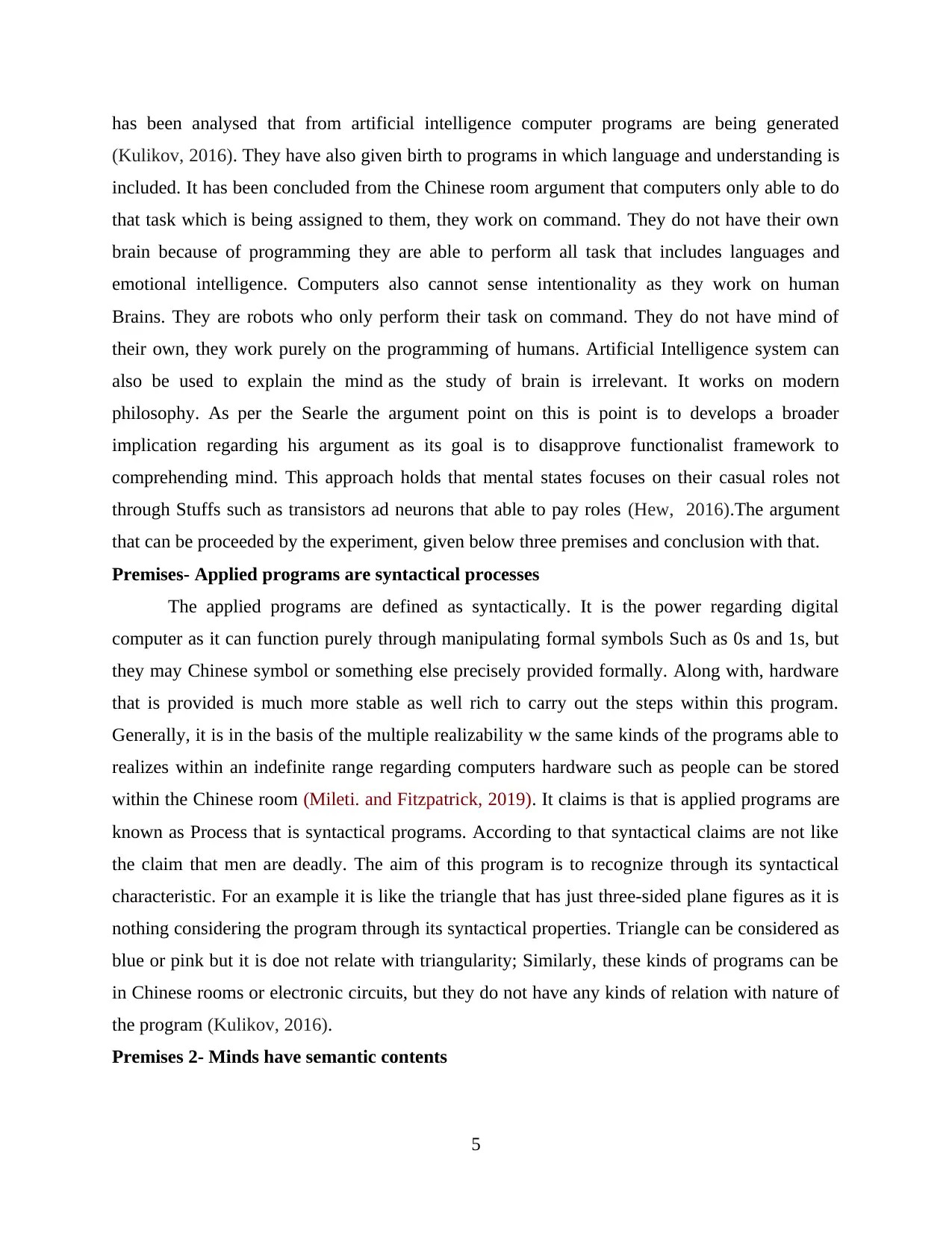
has been analysed that from artificial intelligence computer programs are being generated
(Kulikov, 2016). They have also given birth to programs in which language and understanding is
included. It has been concluded from the Chinese room argument that computers only able to do
that task which is being assigned to them, they work on command. They do not have their own
brain because of programming they are able to perform all task that includes languages and
emotional intelligence. Computers also cannot sense intentionality as they work on human
Brains. They are robots who only perform their task on command. They do not have mind of
their own, they work purely on the programming of humans. Artificial Intelligence system can
also be used to explain the mind as the study of brain is irrelevant. It works on modern
philosophy. As per the Searle the argument point on this is point is to develops a broader
implication regarding his argument as its goal is to disapprove functionalist framework to
comprehending mind. This approach holds that mental states focuses on their casual roles not
through Stuffs such as transistors ad neurons that able to pay roles (Hew, 2016).The argument
that can be proceeded by the experiment, given below three premises and conclusion with that.
Premises- Applied programs are syntactical processes
The applied programs are defined as syntactically. It is the power regarding digital
computer as it can function purely through manipulating formal symbols Such as 0s and 1s, but
they may Chinese symbol or something else precisely provided formally. Along with, hardware
that is provided is much more stable as well rich to carry out the steps within this program.
Generally, it is in the basis of the multiple realizability w the same kinds of the programs able to
realizes within an indefinite range regarding computers hardware such as people can be stored
within the Chinese room (Mileti. and Fitzpatrick, 2019). It claims is that is applied programs are
known as Process that is syntactical programs. According to that syntactical claims are not like
the claim that men are deadly. The aim of this program is to recognize through its syntactical
characteristic. For an example it is like the triangle that has just three-sided plane figures as it is
nothing considering the program through its syntactical properties. Triangle can be considered as
blue or pink but it is doe not relate with triangularity; Similarly, these kinds of programs can be
in Chinese rooms or electronic circuits, but they do not have any kinds of relation with nature of
the program (Kulikov, 2016).
Premises 2- Minds have semantic contents
5
(Kulikov, 2016). They have also given birth to programs in which language and understanding is
included. It has been concluded from the Chinese room argument that computers only able to do
that task which is being assigned to them, they work on command. They do not have their own
brain because of programming they are able to perform all task that includes languages and
emotional intelligence. Computers also cannot sense intentionality as they work on human
Brains. They are robots who only perform their task on command. They do not have mind of
their own, they work purely on the programming of humans. Artificial Intelligence system can
also be used to explain the mind as the study of brain is irrelevant. It works on modern
philosophy. As per the Searle the argument point on this is point is to develops a broader
implication regarding his argument as its goal is to disapprove functionalist framework to
comprehending mind. This approach holds that mental states focuses on their casual roles not
through Stuffs such as transistors ad neurons that able to pay roles (Hew, 2016).The argument
that can be proceeded by the experiment, given below three premises and conclusion with that.
Premises- Applied programs are syntactical processes
The applied programs are defined as syntactically. It is the power regarding digital
computer as it can function purely through manipulating formal symbols Such as 0s and 1s, but
they may Chinese symbol or something else precisely provided formally. Along with, hardware
that is provided is much more stable as well rich to carry out the steps within this program.
Generally, it is in the basis of the multiple realizability w the same kinds of the programs able to
realizes within an indefinite range regarding computers hardware such as people can be stored
within the Chinese room (Mileti. and Fitzpatrick, 2019). It claims is that is applied programs are
known as Process that is syntactical programs. According to that syntactical claims are not like
the claim that men are deadly. The aim of this program is to recognize through its syntactical
characteristic. For an example it is like the triangle that has just three-sided plane figures as it is
nothing considering the program through its syntactical properties. Triangle can be considered as
blue or pink but it is doe not relate with triangularity; Similarly, these kinds of programs can be
in Chinese rooms or electronic circuits, but they do not have any kinds of relation with nature of
the program (Kulikov, 2016).
Premises 2- Minds have semantic contents
5
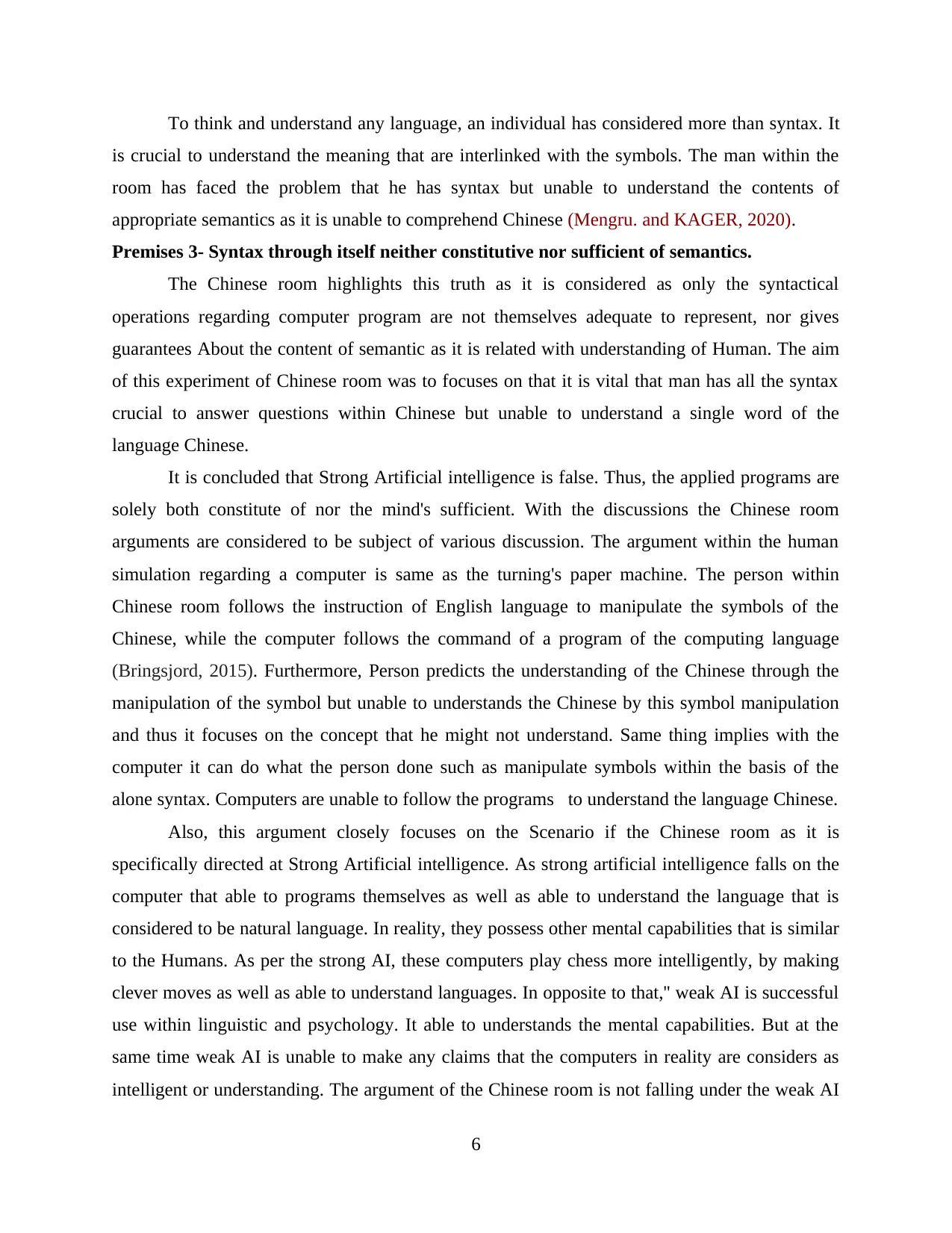
To think and understand any language, an individual has considered more than syntax. It
is crucial to understand the meaning that are interlinked with the symbols. The man within the
room has faced the problem that he has syntax but unable to understand the contents of
appropriate semantics as it is unable to comprehend Chinese (Mengru. and KAGER, 2020).
Premises 3- Syntax through itself neither constitutive nor sufficient of semantics.
The Chinese room highlights this truth as it is considered as only the syntactical
operations regarding computer program are not themselves adequate to represent, nor gives
guarantees About the content of semantic as it is related with understanding of Human. The aim
of this experiment of Chinese room was to focuses on that it is vital that man has all the syntax
crucial to answer questions within Chinese but unable to understand a single word of the
language Chinese.
It is concluded that Strong Artificial intelligence is false. Thus, the applied programs are
solely both constitute of nor the mind's sufficient. With the discussions the Chinese room
arguments are considered to be subject of various discussion. The argument within the human
simulation regarding a computer is same as the turning's paper machine. The person within
Chinese room follows the instruction of English language to manipulate the symbols of the
Chinese, while the computer follows the command of a program of the computing language
(Bringsjord, 2015). Furthermore, Person predicts the understanding of the Chinese through the
manipulation of the symbol but unable to understands the Chinese by this symbol manipulation
and thus it focuses on the concept that he might not understand. Same thing implies with the
computer it can do what the person done such as manipulate symbols within the basis of the
alone syntax. Computers are unable to follow the programs to understand the language Chinese.
Also, this argument closely focuses on the Scenario if the Chinese room as it is
specifically directed at Strong Artificial intelligence. As strong artificial intelligence falls on the
computer that able to programs themselves as well as able to understand the language that is
considered to be natural language. In reality, they possess other mental capabilities that is similar
to the Humans. As per the strong AI, these computers play chess more intelligently, by making
clever moves as well as able to understand languages. In opposite to that,'' weak AI is successful
use within linguistic and psychology. It able to understands the mental capabilities. But at the
same time weak AI is unable to make any claims that the computers in reality are considers as
intelligent or understanding. The argument of the Chinese room is not falling under the weak AI
6
is crucial to understand the meaning that are interlinked with the symbols. The man within the
room has faced the problem that he has syntax but unable to understand the contents of
appropriate semantics as it is unable to comprehend Chinese (Mengru. and KAGER, 2020).
Premises 3- Syntax through itself neither constitutive nor sufficient of semantics.
The Chinese room highlights this truth as it is considered as only the syntactical
operations regarding computer program are not themselves adequate to represent, nor gives
guarantees About the content of semantic as it is related with understanding of Human. The aim
of this experiment of Chinese room was to focuses on that it is vital that man has all the syntax
crucial to answer questions within Chinese but unable to understand a single word of the
language Chinese.
It is concluded that Strong Artificial intelligence is false. Thus, the applied programs are
solely both constitute of nor the mind's sufficient. With the discussions the Chinese room
arguments are considered to be subject of various discussion. The argument within the human
simulation regarding a computer is same as the turning's paper machine. The person within
Chinese room follows the instruction of English language to manipulate the symbols of the
Chinese, while the computer follows the command of a program of the computing language
(Bringsjord, 2015). Furthermore, Person predicts the understanding of the Chinese through the
manipulation of the symbol but unable to understands the Chinese by this symbol manipulation
and thus it focuses on the concept that he might not understand. Same thing implies with the
computer it can do what the person done such as manipulate symbols within the basis of the
alone syntax. Computers are unable to follow the programs to understand the language Chinese.
Also, this argument closely focuses on the Scenario if the Chinese room as it is
specifically directed at Strong Artificial intelligence. As strong artificial intelligence falls on the
computer that able to programs themselves as well as able to understand the language that is
considered to be natural language. In reality, they possess other mental capabilities that is similar
to the Humans. As per the strong AI, these computers play chess more intelligently, by making
clever moves as well as able to understand languages. In opposite to that,'' weak AI is successful
use within linguistic and psychology. It able to understands the mental capabilities. But at the
same time weak AI is unable to make any claims that the computers in reality are considers as
intelligent or understanding. The argument of the Chinese room is not falling under the weak AI
6

nor it able to claim that no machine able to think. According to the Searle, brains are machines
and they also think (Hu, 2018).
From the above discussion it is concluded that strong AI is considered to be true. It
focuses on the that if any computing systems runs within that program, understands Chinese. If
an individual could run a program regarding Chinese without the understanding of the Chinese
than the Strong AI is considered to be false.
The second point focuses on the supported the argument of the Chinese room experiment
as according to that running a program without the understanding of the language, the arguments
of the Sealer's wider arguments it involves the claim about the experiments that focuses that one
is unable to get semantics (meaning) from syntax (formal symbol manipulation) (Kulikov, 2016)
Replies regarding the Chinese room argument
Various criticisms that are regarded narrow Chinese room argument, mention below three
main lines. Some studies state that the person within the room unable to understand Chinese as it
concluded that is no comprehending of Chinese has been created. It can be the strategy regarding
virtual mind reply and system reply. By the helps of such kind of replies hold the outputs of
room represents the comprehending regarding Chinese, but at the same time the room operator is
not considered the computationalism is considered as false.
While on the other side Searle also claims that just by running the natural language is
unable to understands CR scenario unable to creates any kind of understanding as by the
computer or human system. But these are the system that able hold the variation regarding the
system that may be understood. Embedded system within robotic body also having the
interaction with the physical world through motors and sensors or also it is considered as the
system that is simulated the detailed version for the entire brain. Some critics unable to concede
narrow point against Artificial Intelligence. These are the kind of the critics that say that the
main within the Chinese room understands the Chinese, despite being the factors of denials of
the Searle or impossible scenario.
System reply
Searle recognizes as well as discussed various responses regarding arguments that came
across various arguments within Place. With the year 1980, Searle reply that consider to be most
common one is System reply. It was related with the Yale, focuses that the man within the room
unable to understand Chinese. But within the reply the man is considered as the CPU within
7
and they also think (Hu, 2018).
From the above discussion it is concluded that strong AI is considered to be true. It
focuses on the that if any computing systems runs within that program, understands Chinese. If
an individual could run a program regarding Chinese without the understanding of the Chinese
than the Strong AI is considered to be false.
The second point focuses on the supported the argument of the Chinese room experiment
as according to that running a program without the understanding of the language, the arguments
of the Sealer's wider arguments it involves the claim about the experiments that focuses that one
is unable to get semantics (meaning) from syntax (formal symbol manipulation) (Kulikov, 2016)
Replies regarding the Chinese room argument
Various criticisms that are regarded narrow Chinese room argument, mention below three
main lines. Some studies state that the person within the room unable to understand Chinese as it
concluded that is no comprehending of Chinese has been created. It can be the strategy regarding
virtual mind reply and system reply. By the helps of such kind of replies hold the outputs of
room represents the comprehending regarding Chinese, but at the same time the room operator is
not considered the computationalism is considered as false.
While on the other side Searle also claims that just by running the natural language is
unable to understands CR scenario unable to creates any kind of understanding as by the
computer or human system. But these are the system that able hold the variation regarding the
system that may be understood. Embedded system within robotic body also having the
interaction with the physical world through motors and sensors or also it is considered as the
system that is simulated the detailed version for the entire brain. Some critics unable to concede
narrow point against Artificial Intelligence. These are the kind of the critics that say that the
main within the Chinese room understands the Chinese, despite being the factors of denials of
the Searle or impossible scenario.
System reply
Searle recognizes as well as discussed various responses regarding arguments that came
across various arguments within Place. With the year 1980, Searle reply that consider to be most
common one is System reply. It was related with the Yale, focuses that the man within the room
unable to understand Chinese. But within the reply the man is considered as the CPU within
7
Paraphrase This Document
Need a fresh take? Get an instant paraphrase of this document with our AI Paraphraser
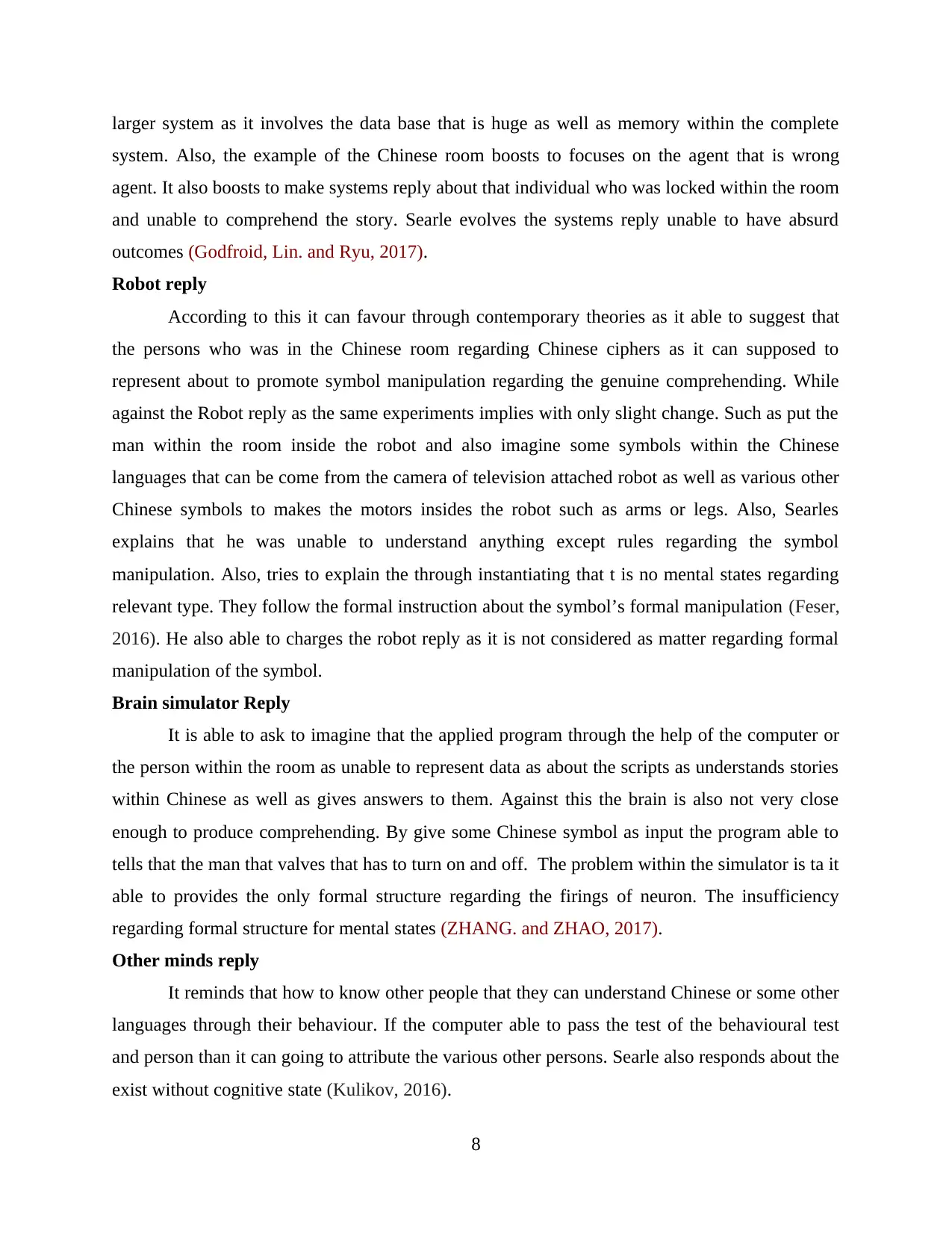
larger system as it involves the data base that is huge as well as memory within the complete
system. Also, the example of the Chinese room boosts to focuses on the agent that is wrong
agent. It also boosts to make systems reply about that individual who was locked within the room
and unable to comprehend the story. Searle evolves the systems reply unable to have absurd
outcomes (Godfroid, Lin. and Ryu, 2017).
Robot reply
According to this it can favour through contemporary theories as it able to suggest that
the persons who was in the Chinese room regarding Chinese ciphers as it can supposed to
represent about to promote symbol manipulation regarding the genuine comprehending. While
against the Robot reply as the same experiments implies with only slight change. Such as put the
man within the room inside the robot and also imagine some symbols within the Chinese
languages that can be come from the camera of television attached robot as well as various other
Chinese symbols to makes the motors insides the robot such as arms or legs. Also, Searles
explains that he was unable to understand anything except rules regarding the symbol
manipulation. Also, tries to explain the through instantiating that t is no mental states regarding
relevant type. They follow the formal instruction about the symbol’s formal manipulation (Feser,
2016). He also able to charges the robot reply as it is not considered as matter regarding formal
manipulation of the symbol.
Brain simulator Reply
It is able to ask to imagine that the applied program through the help of the computer or
the person within the room as unable to represent data as about the scripts as understands stories
within Chinese as well as gives answers to them. Against this the brain is also not very close
enough to produce comprehending. By give some Chinese symbol as input the program able to
tells that the man that valves that has to turn on and off. The problem within the simulator is ta it
able to provides the only formal structure regarding the firings of neuron. The insufficiency
regarding formal structure for mental states (ZHANG. and ZHAO, 2017).
Other minds reply
It reminds that how to know other people that they can understand Chinese or some other
languages through their behaviour. If the computer able to pass the test of the behavioural test
and person than it can going to attribute the various other persons. Searle also responds about the
exist without cognitive state (Kulikov, 2016).
8
system. Also, the example of the Chinese room boosts to focuses on the agent that is wrong
agent. It also boosts to make systems reply about that individual who was locked within the room
and unable to comprehend the story. Searle evolves the systems reply unable to have absurd
outcomes (Godfroid, Lin. and Ryu, 2017).
Robot reply
According to this it can favour through contemporary theories as it able to suggest that
the persons who was in the Chinese room regarding Chinese ciphers as it can supposed to
represent about to promote symbol manipulation regarding the genuine comprehending. While
against the Robot reply as the same experiments implies with only slight change. Such as put the
man within the room inside the robot and also imagine some symbols within the Chinese
languages that can be come from the camera of television attached robot as well as various other
Chinese symbols to makes the motors insides the robot such as arms or legs. Also, Searles
explains that he was unable to understand anything except rules regarding the symbol
manipulation. Also, tries to explain the through instantiating that t is no mental states regarding
relevant type. They follow the formal instruction about the symbol’s formal manipulation (Feser,
2016). He also able to charges the robot reply as it is not considered as matter regarding formal
manipulation of the symbol.
Brain simulator Reply
It is able to ask to imagine that the applied program through the help of the computer or
the person within the room as unable to represent data as about the scripts as understands stories
within Chinese as well as gives answers to them. Against this the brain is also not very close
enough to produce comprehending. By give some Chinese symbol as input the program able to
tells that the man that valves that has to turn on and off. The problem within the simulator is ta it
able to provides the only formal structure regarding the firings of neuron. The insufficiency
regarding formal structure for mental states (ZHANG. and ZHAO, 2017).
Other minds reply
It reminds that how to know other people that they can understand Chinese or some other
languages through their behaviour. If the computer able to pass the test of the behavioural test
and person than it can going to attribute the various other persons. Searle also responds about the
exist without cognitive state (Kulikov, 2016).
8
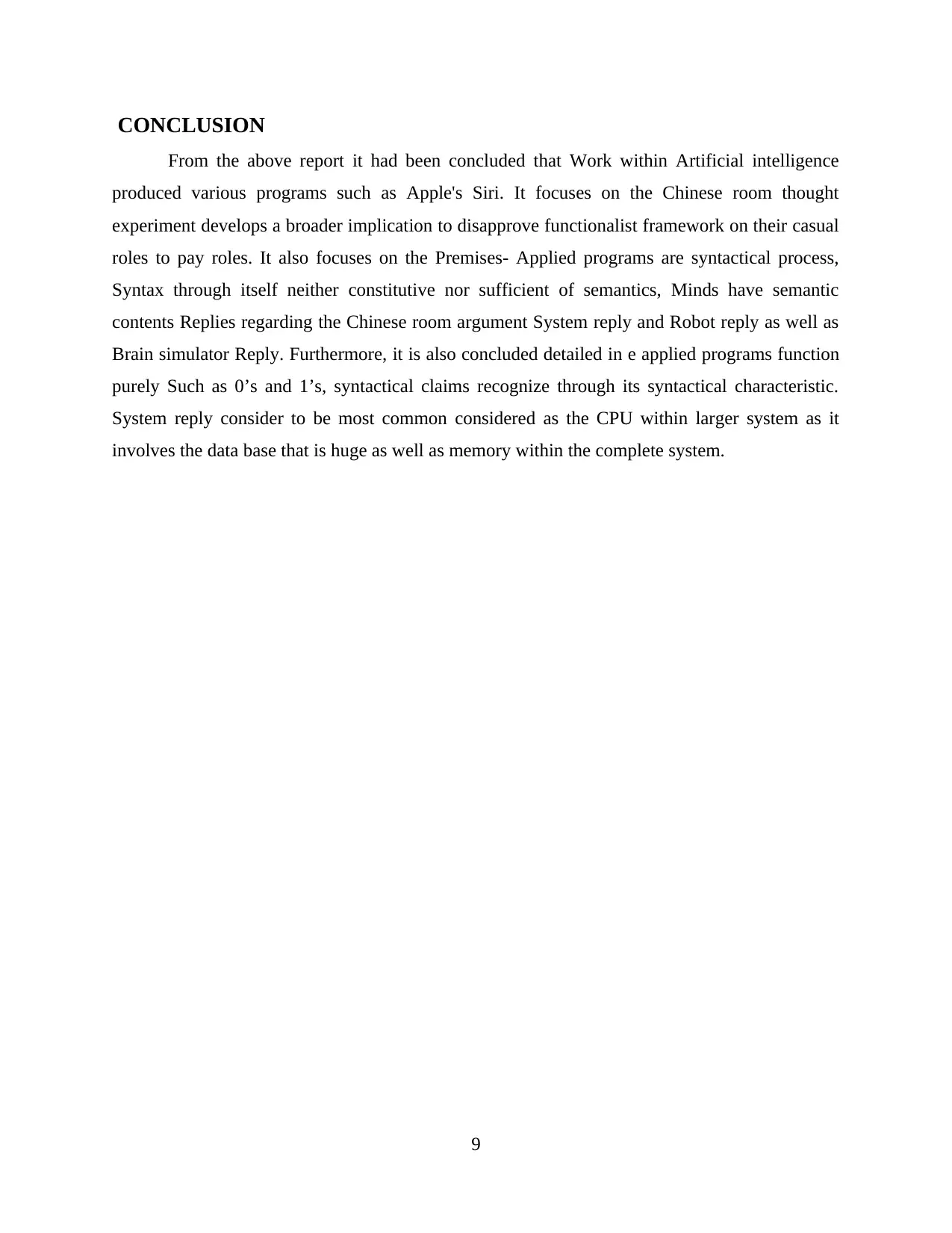
CONCLUSION
From the above report it had been concluded that Work within Artificial intelligence
produced various programs such as Apple's Siri. It focuses on the Chinese room thought
experiment develops a broader implication to disapprove functionalist framework on their casual
roles to pay roles. It also focuses on the Premises- Applied programs are syntactical process,
Syntax through itself neither constitutive nor sufficient of semantics, Minds have semantic
contents Replies regarding the Chinese room argument System reply and Robot reply as well as
Brain simulator Reply. Furthermore, it is also concluded detailed in e applied programs function
purely Such as 0’s and 1’s, syntactical claims recognize through its syntactical characteristic.
System reply consider to be most common considered as the CPU within larger system as it
involves the data base that is huge as well as memory within the complete system.
9
From the above report it had been concluded that Work within Artificial intelligence
produced various programs such as Apple's Siri. It focuses on the Chinese room thought
experiment develops a broader implication to disapprove functionalist framework on their casual
roles to pay roles. It also focuses on the Premises- Applied programs are syntactical process,
Syntax through itself neither constitutive nor sufficient of semantics, Minds have semantic
contents Replies regarding the Chinese room argument System reply and Robot reply as well as
Brain simulator Reply. Furthermore, it is also concluded detailed in e applied programs function
purely Such as 0’s and 1’s, syntactical claims recognize through its syntactical characteristic.
System reply consider to be most common considered as the CPU within larger system as it
involves the data base that is huge as well as memory within the complete system.
9

REFERENCES
Books and journals
Bringsjord, S., 2015. A Refutation of Searle on Bostrom (re: Malicious Machines) and Floridi
(re: Information). APA Newsletter on Philosophy and Computation, 15(1), pp.7-9.
Feser, E., 2016. From Aristotle to John Searle and Back Again: Formal Causes, Teleology, and
Computation in Nature. Nova et vetera, 14(2), pp.459-494.
Gimenes, R., 2015. Sam and the Chinese room. In Proceedings on the International Conference
on Artificial Intelligence (ICAI) (p. 427). The Steering Committee of The World Congress
in Computer Science, Computer Engineering and Applied Computing (WorldComp).
Godfroid, A., Lin, C.H. and Ryu, C., 2017. Hearing and seeing tone through color: An efficacy
study of web‐based, multimodal Chinese tone perception training. Language
Learning, 67(4), pp.819-857.Hew, P.C., 2016. Preserving a combat commander’s moral
agency: The Vincennes Incident as a Chinese Room. Ethics and Information
Technology, 18(3), pp.227-235.
Hu, H., 2018. Effects of Nursing Intervention on Nursing Works in the Operation Room. Journal
of Nursing, 5(2), pp.4-6.
Kulikov, V., 2016. A Multicoding Theory of Cognitive Semantics. Логико-философские
штудии, 13(2), pp.121-122.
Mengru, H.A.N. and KAGER, R., 2020. Pitch properties of infant-directed speech specific to
word-learning contexts: a cross-linguistic investigation of Mandarin Chinese and
Dutch. Journal of Child Language.47(1). pp.85-111.
Mileti, D. and Fitzpatrick, C., 2019. The great earthquake experiment: Risk communication and
public action. Routledge.
Sepetyi, D., 2017. Can the Chinese Robot Think?. Philosophy and Cosmology, 19(19), pp.143-
153.
ZHANG, H.R. and ZHAO, T., 2017. Determination ofα-Bromonaphthalene with β-Cyclodextrin-
induced Room Temperature Phosphorimetry Based on Response Surface
Methodology. Journal of Analytical Science, (6), p.9.
10
Books and journals
Bringsjord, S., 2015. A Refutation of Searle on Bostrom (re: Malicious Machines) and Floridi
(re: Information). APA Newsletter on Philosophy and Computation, 15(1), pp.7-9.
Feser, E., 2016. From Aristotle to John Searle and Back Again: Formal Causes, Teleology, and
Computation in Nature. Nova et vetera, 14(2), pp.459-494.
Gimenes, R., 2015. Sam and the Chinese room. In Proceedings on the International Conference
on Artificial Intelligence (ICAI) (p. 427). The Steering Committee of The World Congress
in Computer Science, Computer Engineering and Applied Computing (WorldComp).
Godfroid, A., Lin, C.H. and Ryu, C., 2017. Hearing and seeing tone through color: An efficacy
study of web‐based, multimodal Chinese tone perception training. Language
Learning, 67(4), pp.819-857.Hew, P.C., 2016. Preserving a combat commander’s moral
agency: The Vincennes Incident as a Chinese Room. Ethics and Information
Technology, 18(3), pp.227-235.
Hu, H., 2018. Effects of Nursing Intervention on Nursing Works in the Operation Room. Journal
of Nursing, 5(2), pp.4-6.
Kulikov, V., 2016. A Multicoding Theory of Cognitive Semantics. Логико-философские
штудии, 13(2), pp.121-122.
Mengru, H.A.N. and KAGER, R., 2020. Pitch properties of infant-directed speech specific to
word-learning contexts: a cross-linguistic investigation of Mandarin Chinese and
Dutch. Journal of Child Language.47(1). pp.85-111.
Mileti, D. and Fitzpatrick, C., 2019. The great earthquake experiment: Risk communication and
public action. Routledge.
Sepetyi, D., 2017. Can the Chinese Robot Think?. Philosophy and Cosmology, 19(19), pp.143-
153.
ZHANG, H.R. and ZHAO, T., 2017. Determination ofα-Bromonaphthalene with β-Cyclodextrin-
induced Room Temperature Phosphorimetry Based on Response Surface
Methodology. Journal of Analytical Science, (6), p.9.
10
1 out of 10
Related Documents
Your All-in-One AI-Powered Toolkit for Academic Success.
+13062052269
info@desklib.com
Available 24*7 on WhatsApp / Email
![[object Object]](/_next/static/media/star-bottom.7253800d.svg)
Unlock your academic potential
© 2024 | Zucol Services PVT LTD | All rights reserved.



